 Web Front-end
Web Front-end uni-app
uni-app UniApp implements the design and development method of API interface encapsulation and request method
UniApp implements the design and development method of API interface encapsulation and request methodUniApp implements the design and development method of API interface encapsulation and request method
Introduction: UniApp is a cross-platform development framework based on Vue.js, which can develop iOS, Android and H5 applications at the same time. In UniApp, the design and development of API interface encapsulation and request methods is a very important part. This article will introduce how to use UniApp to implement the design and development of API interface encapsulation and request methods, and provide relevant code examples.
1. Design API interface encapsulation method
In UniApp, we can uniformly manage and encapsulate all API interfaces for easy calling and management. Generally speaking, we can divide the API interface into different modules, and each module corresponds to a file. We can write the module's routing information, request address, request method and other information in a configuration file and export an object. Next, let's take a closer look at how to design the API interface encapsulation method.
- Create an api folder to store all API interface files.
- Create a config.js file in the api folder to configure the routing information, request address, request method and other information of the interface. The sample code is as follows:
export default {
// 登录接口
login: {
url: '/api/login',
method: 'post'
},
// 获取用户信息接口
getUserInfo: {
url: '/api/user',
method: 'get'
},
// 修改用户信息接口
updateUserInfo: {
url: '/api/user',
method: 'put'
}
};- Create an index.js file in the api folder for unified management and export of all API interfaces. The sample code is as follows:
import config from './config';
const install = Vue => {
if (install.installed) return;
install.installed = true;
Object.defineProperties(Vue.prototype, {
$api: {
get() {
const api = {};
for (const key in config) {
const { url, method } = config[key];
api[key] = (data, options) =>
new Promise((resolve, reject) => {
uni.request({
url,
method,
data,
success: res => {
resolve(res.data);
},
fail: err => {
reject(err);
},
...options
});
});
}
return api;
}
}
});
};
export default {
install
};2. Develop API request method
In UniApp, you can use the uni.request method to send API requests. For ease of use, we can encapsulate a layer of API request methods to make it easier to use and more unified.
- Create a request.js file in the api folder to encapsulate the API request method. The sample code is as follows:
const request = (url, method, data, options) =>
new Promise((resolve, reject) => {
uni.request({
url,
method,
data,
success: res => {
resolve(res.data);
},
fail: err => {
reject(err);
},
...options
});
});
export default request;- Introduce request.js into the index.js file in the api folder, and modify the corresponding code. The sample code is as follows:
import config from './config';
import request from './request';
const install = Vue => {
if (install.installed) return;
install.installed = true;
Object.defineProperties(Vue.prototype, {
$api: {
get() {
const api = {};
for (const key in config) {
const { url, method } = config[key];
api[key] = (data, options) =>
request(url, method, data, options);
}
return api;
}
}
});
};
export default {
install
};3. Use API interface encapsulation and request method
In the UniApp page, we can call the API interface encapsulation and request method through this.$api to process data. ask. The following is a sample code:
<template>
<view>
<button @click="login">登录</button>
</view>
</template>
<script>
export default {
methods: {
login() {
this.$api.login({ username: 'admin', password: '123456' })
.then(res => {
console.log(res);
})
.catch(err => {
console.error(err);
});
}
}
};
</script>In this sample code, the login interface is called by clicking the button to trigger the login method, passing the username and password as parameters. If the request is successful, the returned data will be output on the console. If it fails, an error message will be output on the console.
Conclusion: By using UniApp to implement the design and development of API interface encapsulation and request methods, the code writing and maintenance work can be greatly simplified and development efficiency improved. I hope that the introduction in this article can help you better use UniApp for development. If you have any questions, please leave a message for discussion.
The above is the detailed content of UniApp implements the design and development method of API interface encapsulation and request method. For more information, please follow other related articles on the PHP Chinese website!
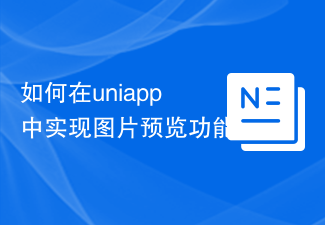 如何在uniapp中实现图片预览功能Jul 04, 2023 am 10:36 AM
如何在uniapp中实现图片预览功能Jul 04, 2023 am 10:36 AM如何在uni-app中实现图片预览功能引言:在移动应用开发中,图片预览是一项常用的功能。在uni-app中,我们可以通过使用uni-ui插件或自定义组件来实现图片预览功能。本文将介绍如何在uni-app中实现图片预览功能,并附带代码示例。一、使用uni-ui插件实现图片预览功能uni-ui是由DCloud开发的一套基于Vue.js的组件库,提供了丰富的UI组
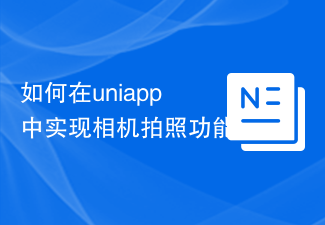 如何在uniapp中实现相机拍照功能Jul 04, 2023 am 09:40 AM
如何在uniapp中实现相机拍照功能Jul 04, 2023 am 09:40 AM如何在uniapp中实现相机拍照功能现在的手机功能越来越强大,几乎每个手机都配备了高像素的相机。在UniApp中实现相机拍照功能,可以为你的应用程序增添更多的交互性和丰富性。本文将针对UniApp,介绍如何使用uni-app插件来实现相机拍照功能,并提供代码示例供参考。一、安装uni-app插件首先,我们需要安装一个uni-app的插件,该插件可以方便地在u
 手把手教你uniapp和小程序分包(图文)Jul 22, 2022 pm 04:55 PM
手把手教你uniapp和小程序分包(图文)Jul 22, 2022 pm 04:55 PM本篇文章给大家带来了关于uniapp跨域的相关知识,其中介绍了uniapp和小程序分包的相关问题,每个使用分包小程序必定含有一个主包。所谓的主包,即放置默认启动页面/TabBar 页面,以及一些所有分包都需用到公共资源/JS 脚本;而分包则是根据开发者的配置进行划分,希望对大家有帮助。
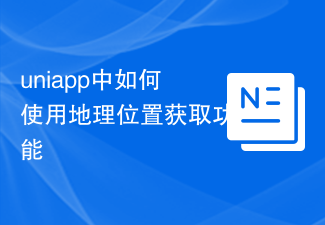 uniapp中如何使用地理位置获取功能Jul 04, 2023 am 08:58 AM
uniapp中如何使用地理位置获取功能Jul 04, 2023 am 08:58 AMuniapp是一种基于Vue.js的跨平台开发框架,它可以同时开发微信小程序、App和H5页面。在uniapp中,我们可以通过使用uni-api来访问设备的各种功能,包括地理位置获取功能。本文将介绍在uniapp中如何使用地理位置获取功能,并附上代码示例。首先,在uniapp中使用地理位置获取功能,我们需要在manifest.json文件中申请权限。在man
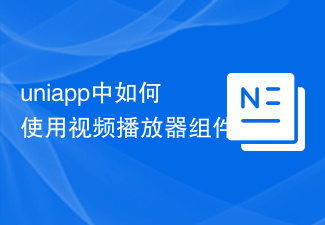 uniapp中如何使用视频播放器组件Jul 04, 2023 am 10:13 AM
uniapp中如何使用视频播放器组件Jul 04, 2023 am 10:13 AMuniapp中如何使用视频播放器组件随着移动互联网的发展,视频已成为人们日常生活中不可或缺的娱乐方式之一。在uniapp中,我们可以通过使用视频播放器组件来实现视频的播放和控制。本文将介绍如何在uniapp中使用视频播放器组件,并提供相应的代码示例。一、引入视频播放器组件在uniapp中,我们需要先引入视频播放器组件才能使用它的功能。可以通过在页面的json
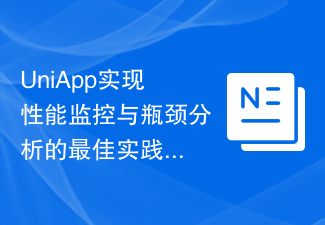 UniApp实现性能监控与瓶颈分析的最佳实践Jul 04, 2023 am 08:46 AM
UniApp实现性能监控与瓶颈分析的最佳实践Jul 04, 2023 am 08:46 AMUniApp实现性能监控与瓶颈分析的最佳实践随着移动应用的快速发展,开发人员对应用性能的需求也日益增加。对于UniApp开发者来说,实现性能监控和瓶颈分析是非常重要的一项工作。本文将介绍UniApp中实现性能监控和瓶颈分析的最佳实践,并提供一些代码示例供参考。一、性能监控的重要性在现代移动应用中,用户体验是非常重要的。性能问题会导致应用加载速度慢、卡顿等问题
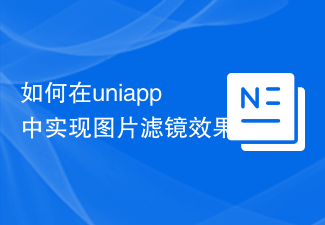 如何在uniapp中实现图片滤镜效果Jul 04, 2023 am 11:05 AM
如何在uniapp中实现图片滤镜效果Jul 04, 2023 am 11:05 AM如何在uniapp中实现图片滤镜效果在移动应用开发中,图片滤镜效果是一种常见且受用户喜爱的功能之一。而在uniapp中,实现图片滤镜效果也并不复杂。本文将为大家介绍如何通过uniapp实现图片滤镜效果,并附上相关代码示例。导入图片首先,我们需要在uniapp项目中导入一张图片,以供后续滤镜效果的处理。可以在项目的资源文件夹中放置一张命名为“filter.jp
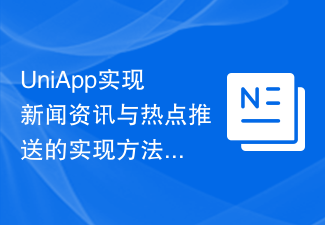 UniApp实现新闻资讯与热点推送的实现方法Jul 04, 2023 am 10:10 AM
UniApp实现新闻资讯与热点推送的实现方法Jul 04, 2023 am 10:10 AMUniApp实现新闻资讯与热点推送的实现方法随着移动互联网的快速发展,新闻资讯和热点推送成为了人们获取信息的重要途径。UniApp是一种基于Vue.js的跨平台开发框架,可以实现一次编写多端运行的效果。在UniApp中,我们可以利用其丰富的组件和插件生态来实现新闻资讯的展示和热点推送功能。一、新闻资讯展示创建页面首先,我们需要在UniApp中创建一个页面来展


Hot AI Tools

Undresser.AI Undress
AI-powered app for creating realistic nude photos

AI Clothes Remover
Online AI tool for removing clothes from photos.

Undress AI Tool
Undress images for free

Clothoff.io
AI clothes remover

AI Hentai Generator
Generate AI Hentai for free.

Hot Article

Hot Tools

Notepad++7.3.1
Easy-to-use and free code editor

MantisBT
Mantis is an easy-to-deploy web-based defect tracking tool designed to aid in product defect tracking. It requires PHP, MySQL and a web server. Check out our demo and hosting services.

DVWA
Damn Vulnerable Web App (DVWA) is a PHP/MySQL web application that is very vulnerable. Its main goals are to be an aid for security professionals to test their skills and tools in a legal environment, to help web developers better understand the process of securing web applications, and to help teachers/students teach/learn in a classroom environment Web application security. The goal of DVWA is to practice some of the most common web vulnerabilities through a simple and straightforward interface, with varying degrees of difficulty. Please note that this software

EditPlus Chinese cracked version
Small size, syntax highlighting, does not support code prompt function

SublimeText3 Linux new version
SublimeText3 Linux latest version





